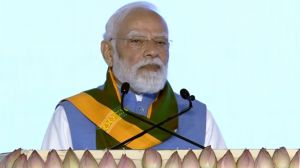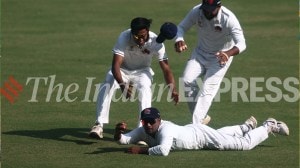In a familiar East End setting,Vijender shows heart and guts
Vijender downed Terrell Gausha to enter the quarter-finals of the 75 kg category.
The ExCel arena for boxing events is in a rainbow borough of London,one in which Indian boxers are likely to feel the most familiar. The East End is about as different from the rest of London as say,Bhiwani,where Vijender Singh trained,is from Bandra,where he occasionally models.
As Vijender downed Terrell Gausha to enter the quarter-finals of the 75 kg category early on Friday India time,the occasional image of the Ray-Bans-wearing,good-loooking young man with a love for branded jeans was as far from the mind as could be.
That was just as well for the East End crowd,having been spectators at bouts of the rawest kind,at rings where photographers dont always turn up,adores the hard-working pugilist and often frowns upon the showman.
As the big,powerfully built American hit out wildly at him,Vijender kept his guard up,but the gritting of his teeth could have ground stone.
With the leader of the Bhiwani brigade through to the next round,it likely wont be just Bollywood-loving NRIs and the IT geeks of Canary Wharf who will come in to watch Vikas Krishan or Manoj Kumar who takes on UKs home boy Thomas Stalker at ExCel.
The multi-cultural neighbourhood is also home to recent immigrants with twisted cross-accents doing all sorts of odd,heavy,labour jobs at the bottom of the employment ladder. This is a corner of London that understands the language of boxing better than most.
Indeed,no other place in London has a sturdier soul than this Canning Town,the original capital of British boxing,not too far from York Hall,the revered old gymnasium which is the spiritual home of the countrys sport. For the dockyard- and factory-labour here,boxing has for years provided recreation in grimy lives. Boxing clubs of West Ham United,Bethnal Green and Repton are all over a 100 years old,while professional gyms where boxing rules were fleshed are spread all over the locality. Here,boxing is town centre,city hall,library and cafeteria rolled into one.
Other famous arenas have had empty seats,but boxings filled up 10,000 seats every single bout of every single session, says Steve Lillis,the local boxing expert. The docks went away as other modes of transport came in. But thankfully,the kids still want to box, he adds.
With time,the profile of immigrants has changed from Afro-Caribbean to Asian. Twenty years ago it was unthinkable that an Asian would box here,now it is unthinkable that at least half of those at the gym wont be Asians. Even Indian immigrants,with no boxing traditions,picked it as easily as anyone else, says Lillis.
Akaash Bhatia known as Kash the Bash from Wembley fought to some popular support here,displaying a derring-do,carefree style not dissimilar to Akhil Kumars.
The areas still blue-collar,and though the docks have died,the spirit hasnt,perhaps because of the change in demographics. The place,home to the likes of Terrence Spinks,the great working-class boxing Olympics hero from the 1950s,who sadly died just days before the London Games opened,finds resonance even now.
Hed (Spinks) have understood Indias boxing roots better than most city folk from either country. He came from the docks,and like Vijender,combined both lives, says Lillis.aik


- 01
- 02
- 03
- 04
- 05





























